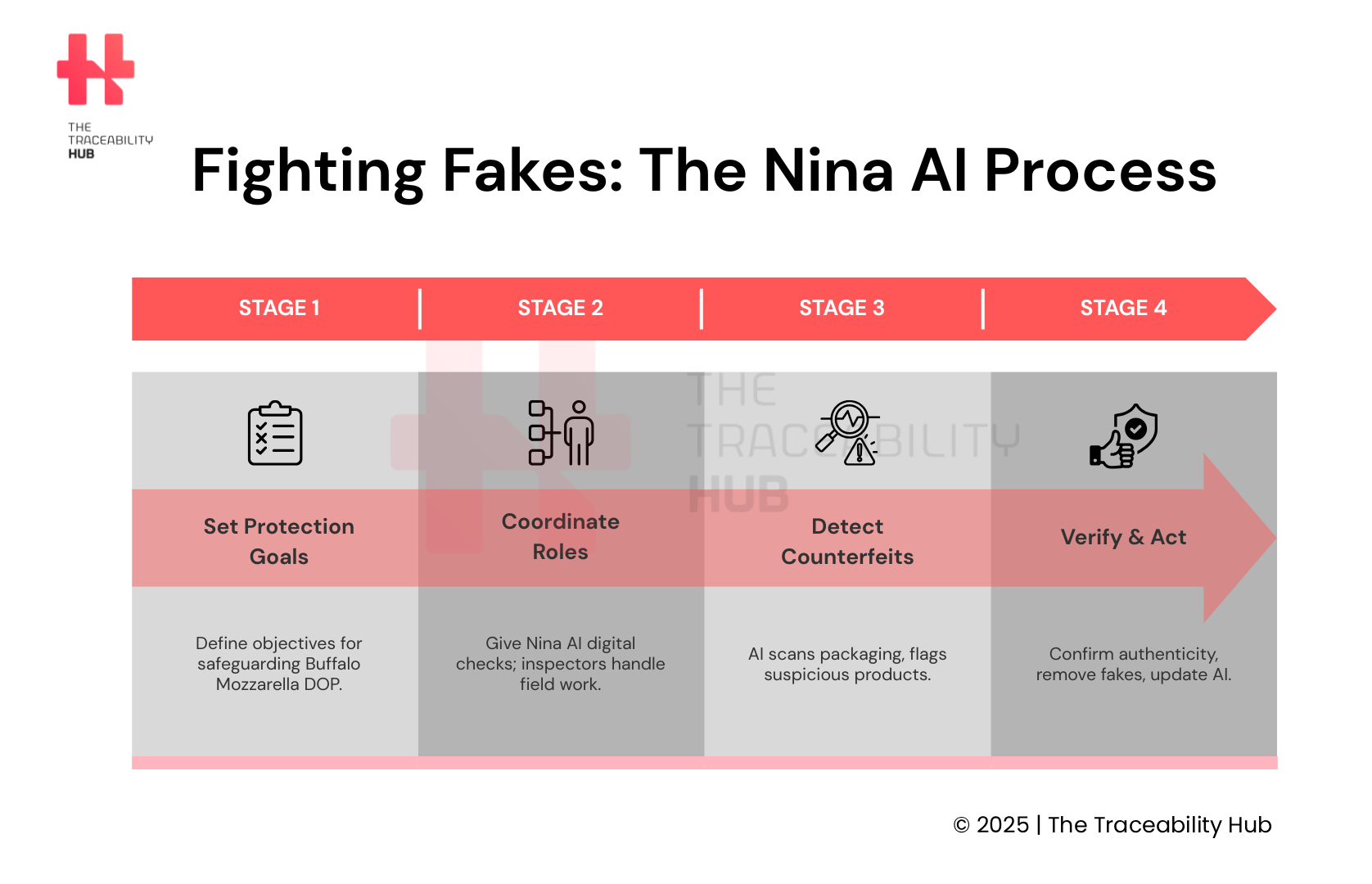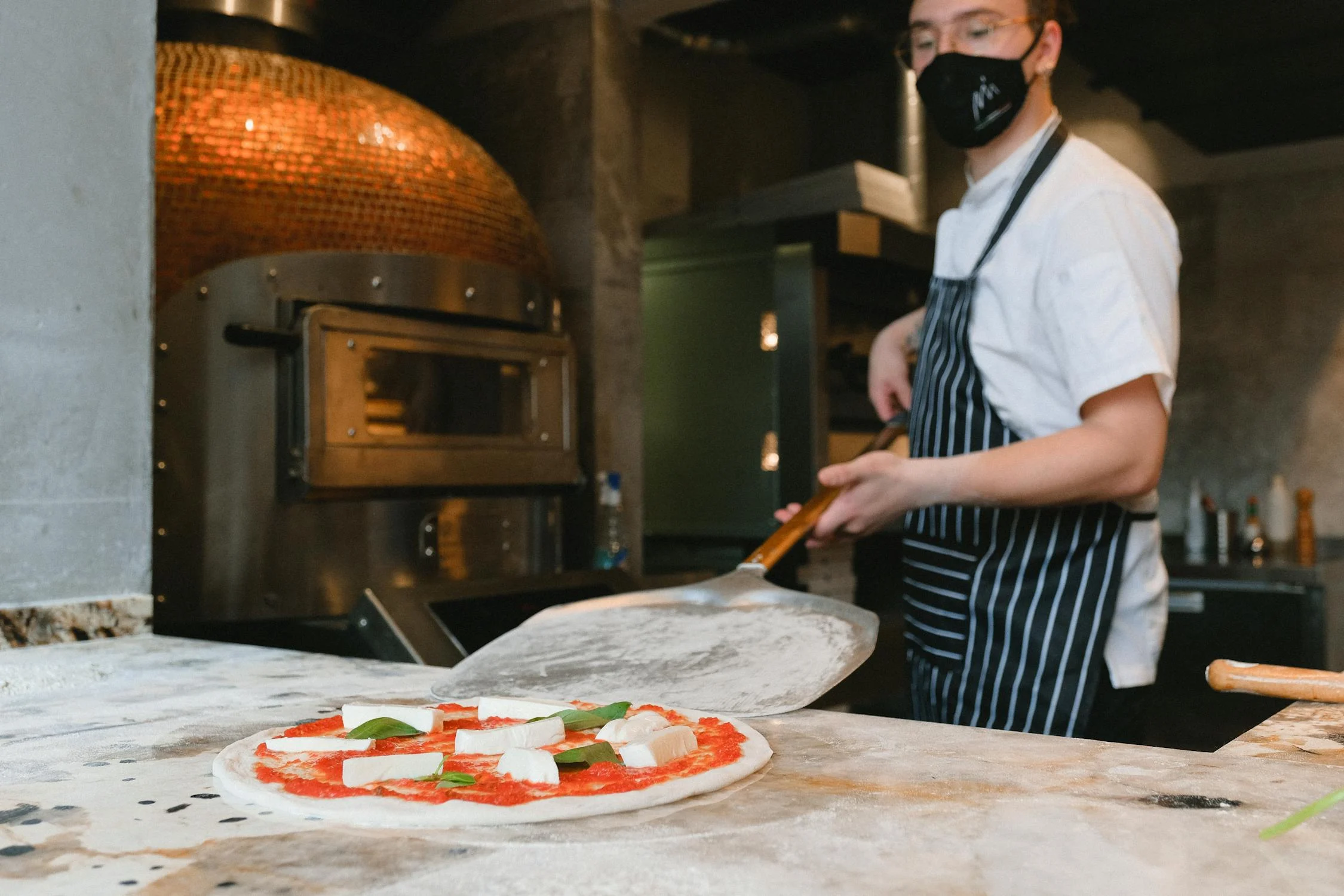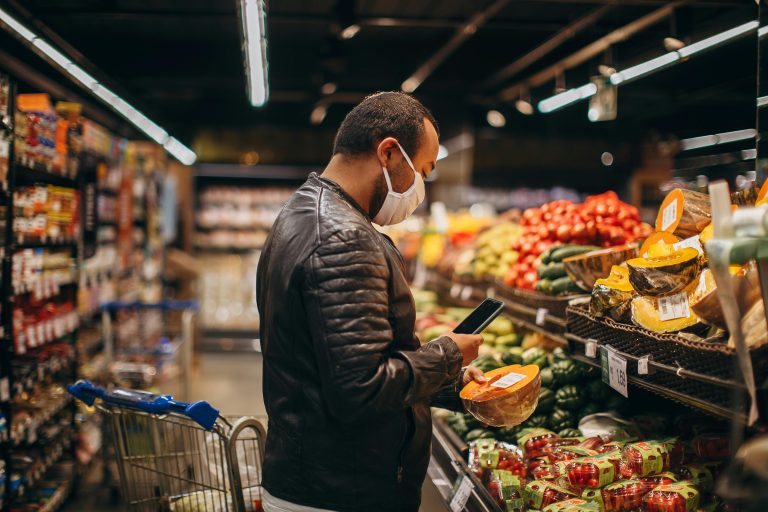Fake Italian products generate $2 billion in illicit profits worldwide through food counterfeiting. Coldiretti, Italy’s national agricultural association, reveals that two-thirds of “Italian” food products sold internationally are fake. American-made cheese from Wisconsin and California makes up 90% of supposedly Italian cheese sold in the United States, including Parmigiano Reggiano and mozzarella.
Authentic Italian cuisine faces a mounting challenge, particularly with protected products like Buffalo Mozzarella DOP, i.e. Protected Designation of Origin.
The Buffalo Mozzarella Consortium has launched “Nina”, an innovative AI food fraud detection system, to curb this widespread deception. This food authenticity AI, created by Farzati Spa, uses advanced technology to verify packaging and safeguard genuine Buffalo Mozzarella DOP’s integrity.
Nina employs seven different algorithms to analyze packaging colors and font styles, offering a robust solution for food traceability and counterfeit protection.
This piece explores the workings of this breakthrough technology and its role as a major step forward in fighting food counterfeiting.
Consortium Deploys Nina AI to Detect Fake Mozzarella
The Consortium for the Protection of Buffalo Mozzarella DOP has started a mission to curb counterfeit products with a new AI system called Nina.
This groundbreaking initiative makes the Consortium Italy’s first organization to use AI technology that protects a DOP product.
Buffalo Mozzarella DOP Faces Rising Counterfeiting Threats
Italian Buffalo Mozzarella continues to battle counterfeiting issues that put consumer health and producer reputation at risk. Authorities recently closed a cheese factory in Campania at the time they found its buffalo mozzarella contained standard cow’s milk, which violated Italian DOP standards. The case resulted in thirteen arrests, including two state-hired veterinarians who allegedly tipped off the factory about upcoming inspections. The counterfeit cheese didn’t just break ingredient rules – it contained twenty times the legally allowed bacteria, creating major health risks.
The problem reaches beyond Italy with “Italian sounding” products – items that use Italian-style names without any real connection to Italy. Some counterfeiters sell their products under names like “mozzabella” to bypass regulations while profiting from the genuine product’s reputation.
Nina AI Developed by Farzati Spa for the Consortium
The Consortium asked Farzati Spa to create Nina, an AI system named after one of the industry’s most productive buffaloes. This digital platform acts as a virtual “bodyguard” for Buffalo Mozzarella DOP. Nina learns to recognize authentic packaging patterns and improves its detection abilities through experience.
AI Food Fraud Detection Enters Italian Agri-Food Sector
This tech-driven approach adds fresh capabilities to existing monitoring efforts. The Consortium performs about 5,000 checks each year. Combined with inspections from Local Health Authorities and Gendarmerie Police officers Carabinieri, the total reaches around 15,000 annual checks – making Buffalo Mozzarella DOP one of Europe’s most protected foods.
Nina watches web content and uses scraping techniques to spot Buffalo Mozzarella DOP references. The system runs seven different algorithms to analyze packaging elements like translations, color scales, fonts, CE stamps, and all regulation-required parameters. Nina flags products for investigation when it spots even one inconsistency.
Nina AI Learns to Authenticate Packaging and Labels
Nina’s technical architecture helps detect counterfeit Buffalo Mozzarella with precision authentication. The system marks the most important step forward in AI food fraud detection technology. It uses multiple analytical approaches to verify if packaging is legitimate.
How Nina Uses Scraping and Pattern Recognition
Nina monitors web content through advanced scraping techniques. The system searches for Buffalo Mozzarella DOP references on digital platforms of all types. Nina’s Optical Character Recognition (OCR) converts text images into machine-readable data. This allows quick and accurate extraction of label information. The system also uses image recognition to spot patterns, logos, and design elements found in authentic Buffalo Mozzarella DOP packaging.
Seven Algorithms Analyze Fonts, Colors, and CE Stamps
Nina’s food authenticity AI runs on seven distinct algorithms. Each algorithm analyzes specific packaging elements:
- Font verification – Checks if typefaces match official standards
- Color scale analysis – Confirms colors match authorized packaging designs
- CE stamp validation – Checks required certification marks
- Translation accuracy – Reviews multilingual text compliance with regulations
- Surface inspection – Spots packaging material flaws
- Dimensional assessment – Matches packaging with size specifications
- Anomaly detection – Spots patterns different from authentic products
System Improves Accuracy Through Continuous Learning
Nina’s power as a counterfeit food protection tool comes from its continuous learning ability. The system uses both supervised and unsupervised learning methods. Nina trains on labeled data from authentic packaging to make better predictions. The system’s unsupervised learning finds patterns in unlabeled data and expands its detection range.
Nina’s deep learning neural networks have multiple layers for complex pattern recognition. This setup helps the system adapt to new counterfeiting methods as they appear. Each analysis makes Nina better at telling real Buffalo Mozzarella DOP from fake ones. This creates a reliable shield against food counterfeiting.
Nina Enhances Traditional Surveillance Systems
Buffalo Mozzarella DOP, Protected Designation of Origin, has always had strong protection measures. Nina AI now adds an extra layer of scrutiny to prevent food counterfeiting. This state-of-the-art technology strengthens the already detailed surveillance system.
15,000 Annual Checks Already in Place
Buffalo Mozzarella DOP benefits from strong protection through regular verification methods. The Consortium performed 5,000 independent checks in 2023. These inspections happen along with checks from other authorized groups like Local Health Authorities, Carabinieri, and Icqrf, the Central Inspectorate for the Protection of Quality and the Repression of Fraud in Agri-food Products.
The combined efforts result in about 15,000 checks each year. This makes Buffalo Mozzarella DOP one of Europe’s most carefully protected food products.
Nina Adds Digital Layer to Physical Inspections
Nina doesn’t just join the existing surveillance system – it adds a digital dimension to regular physical checks. Traditional methods work well in specific areas but struggle to process big data quickly. Nina excels at data handling and predictive analytics. The combination of physical and digital monitoring creates a stronger defense against fake products.
The AI system represents a major improvement in surveillance. Regular detection systems need significant human input. Nina’s AI food fraud detection allows automatic, continuous monitoring across digital platforms. The system uses seven specialized algorithms to analyze packaging elements and flags potential counterfeits quickly and accurately.
AI Supports Producers and Protects Consumers
Nina benefits both producers and consumers. Producers can better protect their reputation and business from fraudulent competition. Consumers get extra confidence in product authenticity.
Nina’s up-to-the-minute detection helps prevent health issues and financial losses. When traditional food safety problems are found too late, they can cause widespread health concerns and get pricey to recall. Nina’s predictive capabilities allow earlier action. The system’s addition to the Consortium’s surveillance platform, 9 years old, shows a progressive approach to protecting against counterfeit food.
Fighting Fakes: The Nina AI Process

Digital Innovation Strengthens Food Traceability
The global food traceability market is growing faster than ever, with projections showing it will reach USD 38.50 billion by 2029. This growth shows how digital innovation has become key to curbing food counterfeiting and giving products authentic verification.
Nina Complements Full Supply Chain Traceability
Nina AI works as a vital part of a complete traceability framework, not as a standalone system. The system boosts existing surveillance through specialized features that verify packaging authenticity. The Buffalo Mozzarella Consortium’s digital traceability systems were 9 years old when Nina came along. Nina’s implementation added extra protection by focusing on package verification. This layered defense makes it harder for sophisticated counterfeiters to succeed.
Buffalo Mozzarella DOP Can Be Traced to Milk Batch
The Buffalo Mozzarella DOP’s traceability system shows incredible precision. Since 2014, everyone in the supply chain must record their production, transfers, and processing. This web-based platform lets users trace a single Buffalo Mozzarella DOP back to its exact milk batch. Such detailed tracking proves product authenticity throughout production.
Food Authenticity AI Builds Consumer Trust
These tech advances directly affect consumer confidence. Studies show that AI-powered traceability improves food safety and regulatory compliance while building consumer trust through transparency. Nina and similar AI systems can analyze unstructured data live and pull information from various sources automatically. Blockchain, AI, and IoT working together have reduced supply chain fraud by up to 30% by creating records that can’t be changed. Digital traceability has become crucial to protecting food authenticity from farm to table.
Fighting Counterfeit Food with AI
Nina AI’s breakthroughs have transformed the battle against counterfeit Buffalo Mozzarella in order to grant a Protected Designation of Origin. This new system marks a major step forward in detecting food fraud by combining digital watchfulness with traditional inspection methods. Seven specialized algorithms work together to create a powerful shield against package tampering. They analyze fonts, color scales and other elements with incredible precision.
Nina adds another layer to an already reliable protection system. Physical inspections covered 15,000 checks annually and created a strong defense. Now, AI provides round-the-clock digital monitoring that human inspectors couldn’t achieve alone. The system acts as a tireless guardian of Buffalo Mozzarella DOP’s authenticity and flags any suspicious products quickly.
The technology creates value for everyone in the food chain. Producers protect their reputation and income, while consumers get better guarantees about what they buy. Knowing how to trace Buffalo Mozzarella to specific milk batches shows the remarkable transparency now available.
Nina shows us a future where AI becomes vital in fighting global food fraud. The food traceability market will reach $38.50 billion by 2029, which confirms this direction. Counterfeiters keep getting smarter, but these digital tools will help preserve protected food products’ integrity.
Nina’s success offers a blueprint for other food consortiums. Fake Italian products alone generate $2 billion in illegal profits yearly. While counterfeiters adapt their tactics, AI systems like Nina evolve through continuous learning. This ensures they stay ahead in the technological race for food authenticity.
Read more: Smart Farming Sensors: The Key to Italian Tomato Profitability






